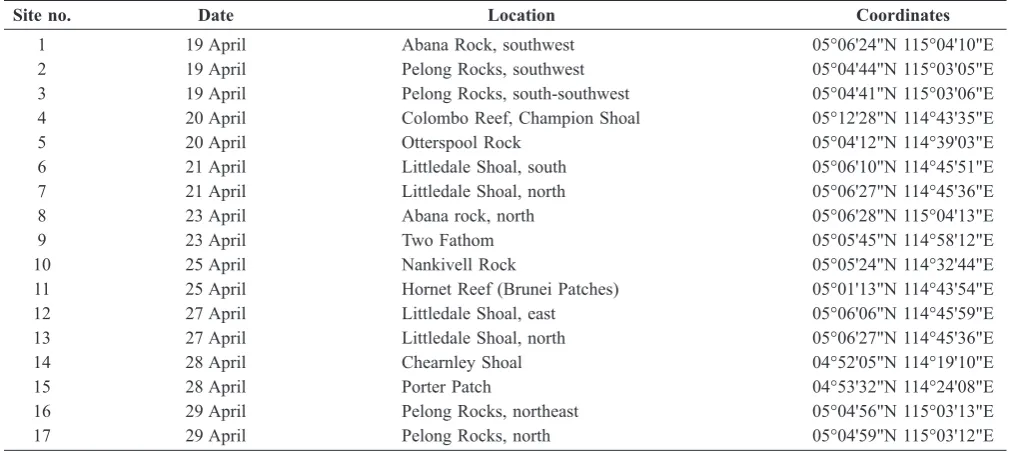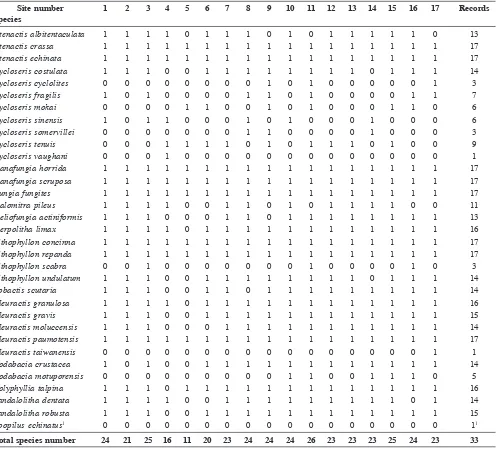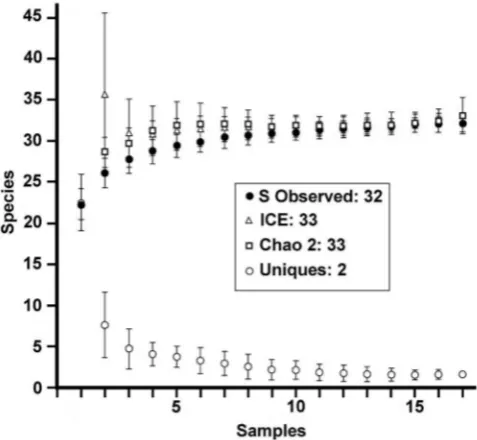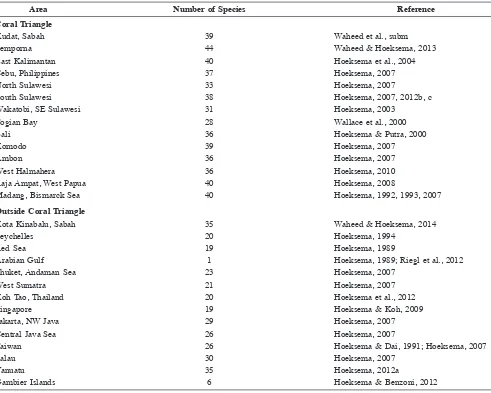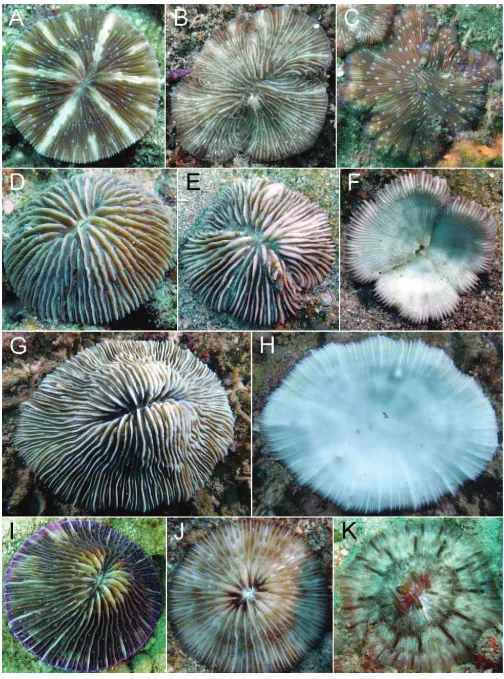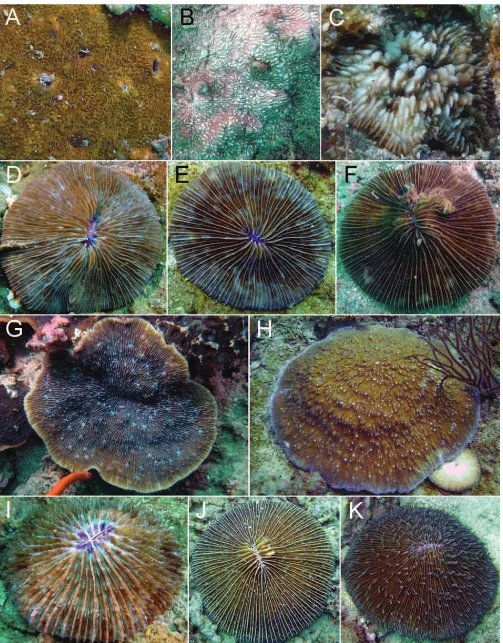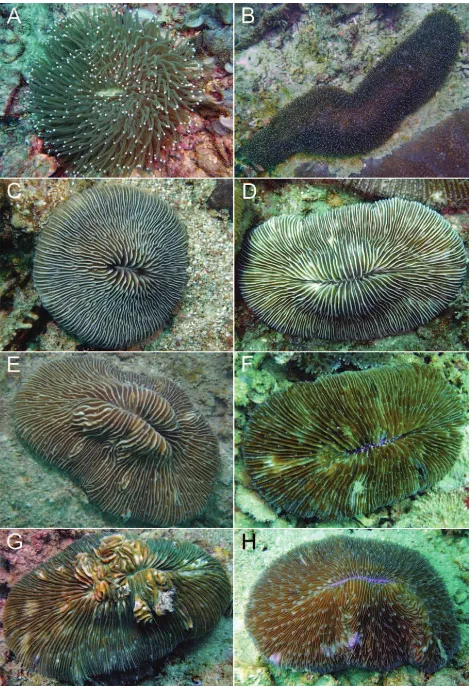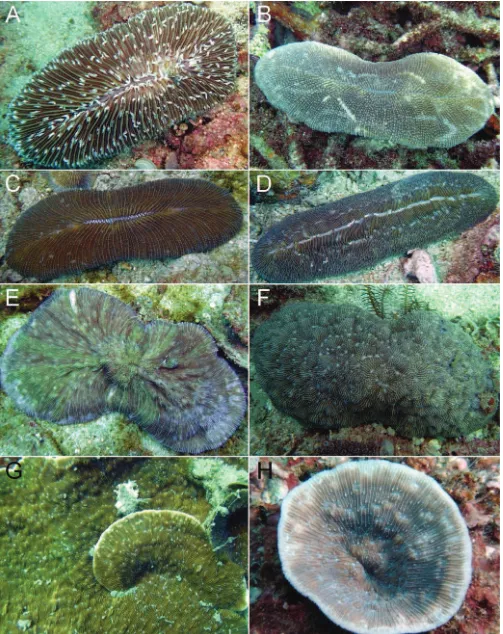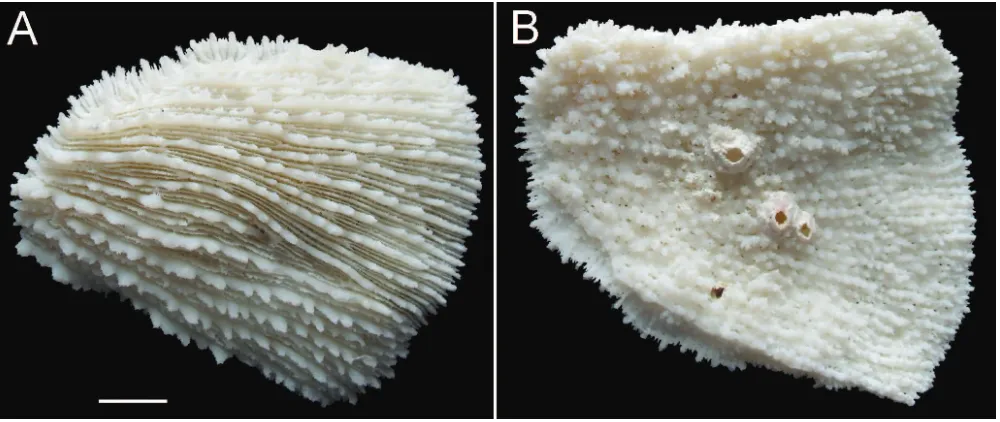The mushroom coral fauna (Scleractinia: Fungiidae) of Brunei
Darussalam (South China Sea) and its relation to the Coral Triangle
Bert W. Hoeksema
1*& David J.W. Lane
2Abstract. Brunei Darussalam is situated on the northwest coast of Borneo, just outside the westernmost boundary of the area presently recognised as the centre of maximum marine biodiversity, the so-called Coral Triangle. This diversity is particularly quantiied with regard to numbers of reef coral species. Most coral reefs of Brunei are offshore, submerged patch reefs, which makes them hard to discern from the water surface. Few coral studies have been carried out here, although recently an extensive reef coral inventory has been published for Brunei. The present study builds on this inventory by presenting a focus on the mushroom coral fauna of Brunei, based on a survey of the family Fungiidae at 17 sites varying in distance offshore. The purpose of this study is to compare the mushroom coral fauna of Brunei with other faunas in the region, which have been surveyed in a similar manner. A total of 33 species has been recorded, which is similar to various locations in the Coral Triangle and other areas around northern Borneo.
Key words. Reef corals, species richness, submerged reefs, Borneo
RAFFLES BULLETIN OF ZOOLOGY
62
: 566–580
Date of publication: 5 August 2014
http://zoobank.org/urn:lsid:zoobank.org:pub:7B5056EC-50B9-4BFE-9B94-061EA6B285E4
© National University of Singapore
ISSN 2345-7600 (electronic) | ISSN 0217-2445 (print)
1Department of Marine Zoology, Naturalis Biodiversity Center P.O. Box 9517, 2300 RA
Leiden, The Netherlands; Email: bert.hoeksema@naturalis.nl (*corresponding author)
2Biology, Faculty of Science, Universiti Brunei Darussalam, Tungku Link, Gadong
BE 1410, Brunei Darussalam; Email: david.lane@ubd.edu.bn
Conservation & Ecology
INTRODUCTION
Brunei Darussalam has numerous submerged patch reefs,
which together are less than 100 km
2in extent and situated on
the continental shelf in the South China Sea at the northwest
coast of Borneo (DeVantier & Turak, 2009; Lane, 2011).
Despite their proximity to the Coral Triangle (Hoeksema,
2007; Veron et al., 2009), little was known about these
reefs until a few years ago, except for one study that was
carried out several decades earlier (Chua et al., 1987). This
lack of information in the past was not extraordinary when
compared to many other reef areas in the South China Sea
(Huang et al., 2014). However, reef surveys have been
carried out lately to assess the reef environments and reef
coral diversity of Brunei (DeVantier & Turak, 2009; Turak
& DeVantier, 2011), and also to monitor threats to its coral
fauna, such as coral bleaching and coral predator outbreaks
(Lane, 2011, 2012).
In order to compare Brunei’s reef coral assemblages with
other coral faunas in Southeast Asia, in particular northern
Borneo and the Coral Triangle, the mushroom coral family
Fungiidae was selected as a proxy. Fungiid scleractinians
have been included in previous studies for Brunei waters
(Turak & DeVantier, 2011; Lane & Lim, 2013) but they never
been surveyed comprehensively at this location. This family
of over 50 species (Hoeksema, 1989, 2014; Gittenberger
et al., 2011; Benzoni et al.
,
2012) has also been targeted in
contemporaneous reef coral studies in nearby Sabah, eastern
Malaysia (Waheed & Hoeksema, 2013, 2014; Waheed et
al., subm), and in areas like Singapore (Hoeksema, 2009;
Hoeksema & Koh, 2009) and Berau, East Kalimantan
(Hoeksema et al., 2004).
This comparison will show how closely Brunei may be
related to other areas in Southeast Asia and the Coral
Triangle with regard to its mushroom coral fauna, which
is of interest because the Coral Triangle receives much
attention with regard to coral reef management (Clifton,
2009; Mills et al., 2010; Carpenter et al., 2011; White
et al., 2014). The species richness of Brunei is also of
biogeographical importance because this country is situated
near the westernmost boundary of the Coral Triangle, which
has shifted over recent years (Green & Mous, 2004, 2008;
Hoeksema, 2007; Veron et al., 2009, 2011).
MATERIAL AND METHODS
(Figs. 3–6) for species comparison. Four other sites were
visited but excluded from the analysis because they were
either shipwrecks or a 13 m deep sandy shoal with only a
thin cover of solitary zoantharians of the genus
Sphenopus
(Reimer et al., 2012).
Analysis.
In order to verify whether sampling was suficient
for obtaining a representative indication of the mushroom
coral fauna for the whole area, species richness estimators
were calculated using EstimateS 8.20 (Colwell, 2009). These
estimators are illustrated as species accumulation curves in
which the sample order has been randomised and the values
have been averaged. The calculated mean values and standard
deviations of the species richness at the sample numbers
show an averaged rate at which additional species were
found in the course of consecutive dives with an asymptote
that indicates the expected total species richness (Magurran,
2004). The species richness estimators used for incidence
data (presence/absence) are Chao 2 and ICE (Colwell,
2009). Presence/absence data for two
Cycloseris
species
Table 1. Localities visited during mushroom coral ield survey off Brunei in 2011.
Site no. Date Location Coordinates
1 19 April Abana Rock, southwest 05°06'24"N 115°04'10"E
2 19 April Pelong Rocks, southwest 05°04'44"N 115°03'05"E
3 19 April Pelong Rocks, south-southwest 05°04'41"N 115°03'06"E
4 20 April Colombo Reef, Champion Shoal 05°12'28"N 114°43'35"E
5 20 April Otterspool Rock 05°04'12"N 114°39'03"E
6 21 April Littledale Shoal, south 05°06'10"N 114°45'51"E
7 21 April Littledale Shoal, north 05°06'27"N 114°45'36"E
8 23 April Abana rock, north 05°06'28"N 115°04'13"E
9 23 April Two Fathom 05°05'45"N 114°58'12"E
10 25 April Nankivell Rock 05°05'24"N 114°32'44"E
11 25 April Hornet Reef (Brunei Patches) 05°01'13"N 114°43'54"E
12 27 April Littledale Shoal, east 05°06'06"N 114°45'59"E
13 27 April Littledale Shoal, north 05°06'27"N 114°45'36"E
14 28 April Chearnley Shoal 04°52'05"N 114°19'10"E
15 28 April Porter Patch 04°53'32"N 114°24'08"E
16 29 April Pelong Rocks, northeast 05°04'56"N 115°03'13"E
17 29 April Pelong Rocks, north 05°04'59"N 115°03'12"E
Fig. 1. Map of the coastal area of Brunei indicating survey sites listed in Table 1. Adapted from Brunei Shell Petroleum Company Snd. Bhd. and Environmental Resources Management Hong Kong.
that previously belonged to the Siderastreidae (Benzoni et
al., 2007, 2012), were recorded for Brunei but not for each
separate site. These taxa were therefore excluded from the
species richness analysis. Regarding the total of 17 survey
sites, species were considered rare (when found at 1–3
sites), uncommon (at 4–6 sites), moderately common (at
7–11 sites), common (at 12–14 sites), and very common (at
15–17 sites). The present results are compared with those of
previous studies dealing with the mushroom coral fauna of
Brunei (Chou et al., 1987; Turak & DeVantier, 2011) and with
those in other areas where the same method was used. Some
specimens sampled by Turak & DeVantier (2011) have been
deposited at the Fisheries Department Marine Biodiversity
Centre, Brunei Darussalam. This collection was examined
for partial veriication of earlier species records that were
not obtained by the present survey.
RESULTS
Table 2. Records (presence/absence) of mushroom coral species encountered off Brunei at 17 localities in 2011 (nomenclature after Gittenberger et al., 2011). Cycloseris explanulata and C. wellsi, although present at Brunei (Fig. 4A, B), were not included in the records, because they were not yet considered Fungiidae at the time of the survey (Benzoni et al., 2012).
Site number 1 2 3 4 5 6 7 8 9 10 11 12 13 14 15 16 17 Records
Species
Ctenactis albitentaculata 1 1 1 1 0 1 1 1 0 1 0 1 1 1 1 1 0 13
Ctenactis crassa 1 1 1 1 1 1 1 1 1 1 1 1 1 1 1 1 1 17
Ctenactis echinata 1 1 1 1 1 1 1 1 1 1 1 1 1 1 1 1 1 17
Cycloseris costulata 1 1 1 0 0 1 1 1 1 1 1 1 1 0 1 1 1 14
Cycloseris cyclolites 0 0 0 0 0 0 0 0 1 0 1 0 0 0 0 0 1 3
Cycloseris fragilis 1 0 1 0 0 0 0 1 1 0 1 0 0 0 0 1 1 7
Cycloseris mokai 0 0 0 0 1 1 0 0 1 0 1 0 0 0 1 1 0 6
Cycloseris sinensis 1 0 1 1 0 0 0 1 0 1 0 0 0 1 0 0 0 6
Cycloseris somervillei 0 0 0 0 0 0 0 1 1 0 0 0 0 1 0 0 0 3
Cycloseris tenuis 0 0 0 1 1 1 1 0 1 0 1 1 1 0 1 0 0 9
Cycloseris vaughani 0 0 0 1 0 0 0 0 0 0 0 0 0 0 0 0 0 1
Danafungia horrida 1 1 1 1 1 1 1 1 1 1 1 1 1 1 1 1 1 17
Danafungia scruposa 1 1 1 1 1 1 1 1 1 1 1 1 1 1 1 1 1 17
Fungia fungites 1 1 1 1 1 1 1 1 1 1 1 1 1 1 1 1 1 17
Halomitra pileus 1 1 1 1 0 0 1 1 0 1 0 1 1 1 1 0 0 11
Heliofungia actiniformis 1 1 1 0 0 0 1 1 0 1 1 1 1 1 1 1 1 13
Herpolitha limax 1 1 1 1 0 1 1 1 1 1 1 1 1 1 1 1 1 16
Lithophyllon concinna 1 1 1 1 1 1 1 1 1 1 1 1 1 1 1 1 1 17
Lithophyllon repanda 1 1 1 1 1 1 1 1 1 1 1 1 1 1 1 1 1 17
Lithophyllon scabra 0 0 1 0 0 0 0 0 0 0 1 0 0 0 0 1 0 3
Lithophyllon undulatum 1 1 1 0 0 1 1 1 1 1 1 1 1 0 1 1 1 14
Lobactis scutaria 1 1 1 0 0 1 1 0 1 1 1 1 1 1 1 1 1 14
Pleuractis granulosa 1 1 1 1 0 1 1 1 1 1 1 1 1 1 1 1 1 16
Pleuractis gravis 1 1 1 0 0 1 1 1 1 1 1 1 1 1 1 1 1 15
Pleuractis moluccensis 1 1 1 0 0 0 1 1 1 1 1 1 1 1 1 1 1 14
Pleuractis paumotensis 1 1 1 1 1 1 1 1 1 1 1 1 1 1 1 1 1 17
Pleuractis taiwanensis 0 0 0 0 0 0 0 0 0 0 0 0 0 0 0 0 1 1
Podabacia crustacea 1 0 1 0 0 1 1 1 1 1 1 1 1 1 1 1 1 14
Podabacia motuporensis 0 0 0 0 0 0 0 0 0 1 1 0 0 1 1 1 0 5
Polyphyllia talpina 1 1 1 0 1 1 1 1 1 1 1 1 1 1 1 1 1 16
Sandalolitha dentata 1 1 1 1 0 0 1 1 1 1 1 1 1 1 1 0 1 14
Sandalolitha robusta 1 1 1 0 0 1 1 1 1 1 1 1 1 1 1 1 1 15
Zoopilus echinatus1 0 0 0 0 0 0 0 0 0 0 0 0 0 0 0 0 0 11
Total species number 24 21 25 16 11 20 23 24 24 24 26 23 23 23 25 24 23 33
1Record of Zoopilus echinatus is based on a museum specimen (Fig. 7)
SPECIES ACCOUNT
Ctenactis albitentaculata Hoeksema, 1989
(Fig. 6A)
Ctenactis albitentaculata – Turak & DeVantier, 2011: 140.
This free-living species is common at Brunei: recorded at
13 out of 17 sites (Table 2). Occasionally, clusters of 3–6
specimens were observed, all with tentacles extended.
Ctenactis crassa (Dana, 1846)
(Fig. 6B)
Ctenactis crassa – Turak & DeVantier, 2011: 140.
This free-living species is very common at Brunei: recorded
at all 17 sites (Table 2).
Ctenactis echinata (Pallas, 1766)
(Fig. 6C)
Fungia echinata – Chou et al., 1987: 47.
Ctenactis echinata – Turak & DeVantier, 2011: 141.
This free-living species is very common at Brunei: recorded
at all 17 sites (Table 2).
Cycloseris costulata (Ortmann, 1889)
(Fig. 3I)
Cycloseris costulata – Turak & DeVantier, 2011: 126.
Cycloseris erosa – Turak & DeVantier, 2011: 127.
Fig. 2. Species richness estimators (Colwell, 2009) for Fungiidae recorded at 17 sites off Brunei. The curves indicate that the occurrence of one additional species is possible when the maximum number of observed species (S Obs = 32) is compared to the maximum expected numbers (ICE, Chao 2 = 33). Only two species (Uniques) are each represented by a single individual.
This free-living species is common at Brunei: recorded at 14
out of 17 sites (Table 2). It was not observed in fragmenting
shape. Although the illustrated specimen has a violet margin
(Fig. 3I), the usual colour of this species is even brown
(Gittenberger & Hoeksema, 2006). It has also been recorded
as
C. erosa
(Döderlein, 1901) (see Turak & DeVantier, 2011),
which actually is a synonym for
C. tenuis
(see Hoeksema,
1989). The colouration of a specimen illustrated and identiied
as
C. vaughani
by
Turak & DeVantier (2011) is typical for
C. costulata
(compare Hoeksema, 1989; Hoeksema & Van
Ofwegen, 2004; Gittenberger & Hoeksema, 2006). The
costae of another specimen illustrated and identiied as
C.
vaughani
by
Turak & DeVantier (2011) resembles those of
C. boschmai
Hoeksema, 2014, which has not been found
during the present study, although it has been recorded at
the reefs of Kota Kinabalu, located 150 km away in a NE
direction (Waheed & Hoeksema, 2014). In comparison to
C.
boschmai
and
C. vaughani
, C.
costulata
has less pronounced
lower order costae.
Cycloseris cyclolites (Lamarck, 1816)
(Fig. 3D–F)
Cycloseris cyclolites – Turak & DeVantier, 2011: 126.
This free-living species is rare at Brunei: recorded at 3 out
of 17 sites (Table 2). It was observed in complete (Fig. 3D)
and in fragmenting shape (Fig. 3E, F), the so-called
Diaseris
form (see Hoeksema, 1989: Figs. 83, 84).
Cycloseris explanulata (Van der Horst, 1922)
(Fig. 4A)
Psammocora explanulata
– Turak & DeVantier, 2011: 105.
This encrusting species is uncommon at Brunei (Turak &
DeVantier, 2011). At the time of this survey it was considered
to belong to the Siderastreidae, but based on morphological
and molecular evidence (Benzoni et al., 2007), it was moved
to the Fungiidae (Benzoni et al., 2012). Although this species
was noted in the ield, sites for this taxon were not recorded
in the presence/absence survey.
Cycloseris fragilis (Alcock, 1893)
(Fig. 3A, B)
Cycloseris patelliformis – Turak & DeVantier, 2011: 128.
Diaseris distorta (partim) – Turak & DeVantier, 2011: 130. Not Diaseris fragilis – Turak & DeVantier, 2011: 131 (= C. sinensis).
This free-living species is moderately common at Brunei:
recorded at 7 out of 17 sites (Table 2). It was observed
in complete and in fragmenting shape. It has also been
recorded as
C. patelliformis
(Boschma, 1923) (see
Turak &
DeVantier, 2011), which actually is a synonym of
C. fragilis
(see Hoeksema, 1989). Live specimens photographed in
Indonesia and identiied as
D. distorta
by
Turak & DeVantier
(2011) show thin septa, which are typical for
C. fragilis
and
not for
C. distorta
(compare Hoeksema, 1989).
Diaseris
is considered a synonym of
Cycloseris
(Hoeksema, 1989;
Hoeksema & Waheed, 2011, 2012).
Cycloseris mokai (Hoeksema, 1989)
(Fig. 4C)
Lithophyllon mokai – Turak & DeVantier, 2011: 145.
This encrusting species is uncommon at Brunei: recorded
at 6 out of 17 sites (Table 2).
Cycloseris sinensis Milne Edwards & Haime, 1851
(Fig. 3C)
Cycloseris sinensis – Turak & DeVantier, 2011: 145.
Diaseris distorta (partim) – Turak & DeVantier, 2011: 130.
This free-living species is common at Brunei: recorded at
6 out of 17 sites (Table 2). It was observed in complete
and in fragmenting shape, the so-called
Diaseris
form (see
Hoeksema, 1989: Figs. 48–54). A fragmented specimen
identiied as
Diaseris distorta
and shown in a black and
white photograph by Turak & DeVantier (2011) is actually
a specimen of
C. sinensis.
Cycloseris somervillei (Gardiner, 1909)
(Fig. 3G, H)
Not Cycloseris somervillei – Turak & DeVantier, 2011: 131 (=
Lobactis scutaria).
Table 3. Mushroom coral records from Indo-Paciic areas as comparison to the present results from Brunei (33 species), with a distinction
between records from inside and outside the Coral Triangle.
Area Number of Species Reference
Coral Triangle
Kudat, Sabah 39 Waheed et al., subm
Semporna 44 Waheed & Hoeksema, 2013
East Kalimantan 40 Hoeksema et al., 2004
Cebu, Philippines 37 Hoeksema, 2007
North Sulawesi 33 Hoeksema, 2007
South Sulawesi 38 Hoeksema, 2007, 2012b, c Wakatobi, SE Sulawesi 31 Hoeksema, 2003
Togian Bay 28 Wallace et al., 2000
Bali 36 Hoeksema & Putra, 2000
Komodo 39 Hoeksema, 2007
Ambon 36 Hoeksema, 2007
West Halmahera 36 Hoeksema, 2010
Raja Ampat, West Papua 40 Hoeksema, 2008
Madang, Bismarck Sea 40 Hoeksema, 1992, 1993, 2007
Outside Coral Triangle
Kota Kinabalu, Sabah 35 Waheed & Hoeksema, 2014
Seychelles 20 Hoeksema, 1994
Red Sea 19 Hoeksema, 1989
Arabian Gulf 1 Hoeksema, 1989; Riegl et al., 2012
Phuket, Andaman Sea 23 Hoeksema, 2007
West Sumatra 21 Hoeksema, 2007
Koh Tao, Thailand 20 Hoeksema et al., 2012
Singapore 19 Hoeksema & Koh, 2009
Jakarta, NW Java 29 Hoeksema, 2007
Central Java Sea 26 Hoeksema, 2007
Taiwan 26 Hoeksema & Dai, 1991; Hoeksema, 2007
Palau 30 Hoeksema, 2007
Vanuatu 35 Hoeksema, 2012a
Gambier Islands 6 Hoeksema & Benzoni, 2012
Cycloseris tenuis (Dana, 1846)
(Fig. 3J)
Not Cycloseris tenuis – Turak & DeVantier, 2011: 129 (= Pleuractis granulosa, Cycloseris spp.).
This free-living species is moderately common at Brunei:
recorded at 9 out of 17 sites (Table 2). The lower order
costae are large and roughly ornamented. The species has
a typical greyish-brown colour with dark brown around its
mouth and white lips (Gittenberger & Hoeksema, 2006). The
specimens from Indonesia illustrated by Turak & DeVantier
(2011) are wrongly identiied.
Cycloseris vaughani (Boschma, 1923)
(Fig. 3K)
Not Cycloseris vaughani – Turak & DeVantier, 2011: 129
(=Cycloseris costulata).
This free-living species is rare at Brunei: recorded only at
Colombo Reef, Champion Shoal (Table 2). The lower order
costae are larger and sharper than in its congeners. The
species has a patchy greyish-brown colour, usually with a
radiating pattern (Fig. 2K; Hoeksema, 1989; Hoeksema &
Van Ofwegen, 2004). The specimens illustrated by Turak &
DeVantier (2011) are wrongly identiied.
Cycloseris wellsi (Veron & Pichon, 1980)
(Fig. 4B)
Coscinarea wellsi – Turak & DeVantier, 2011: 110.
This encrusting species is rare at Brunei (Turak & DeVantier,
2011). Previously it was considered to belong to the
Siderastreidae but based on morphological and molecular
evidence (Benzoni et al., 2007) this species was moved to
the Fungiidae (Benzoni et al., 2012). Although this species
was noted in the ield, sites for this taxon were not recorded
in the presence/absence survey.
Danafungia horrida (Dana, 1846)
(Fig. 4I)
Fungia horrida – Turak & DeVantier, 2011: 135.
Fig. 4. A, Cycloseris explanulata at Porter Patch; B, Cycloseris wellsi at Abana Rock, north; C, Cycloseris mokai at Littledale Shoal, south; D, Lithophyllon scabra at Hornet Reef (Brunei Patches); E, Lithophyllon concinna at Abana Rock, south; F, Lithophyllon repanda
at Abana Rock, north; G, Lithophyllon undulatum at Abana Rock, south; H, Halomitra pileus at Abana Rock, south; I, Danafungia horrida
This free-living species is very common at Brunei: recorded
at all 17 sites (Table 2).
Danafungia scruposa (Klunzinger, 1879)
(Fig. 4J)
Fungia corona – Turak & DeVantier, 2011: 132.
Fungia danai – Turak & DeVantier, 2011: 133.
Fungia scruposa – Turak & DeVantier, 2011: 138.
This free-living species is very common at Brunei: recorded
at all 17 sites (Table 2).
Fungia fungites (Linnaeus, 1758)
(Fig. 4K)
Fungia fungites – Chou et al., 1987: 47; Turak & DeVantier,
2011: 133.
This free-living species is very common at Brunei: recorded
at all 17 sites (Table 2).
Halomitra pileus (Linnaeus, 1758)
(Fig. 4H)
Halomitra pileus – Chou et al., 1987: 47; Turak & DeVantier,
2011: 144.
This free-living species is common at Brunei: recorded at
11 out of 17 sites (Table 2). High numbers of very large
specimens (diameter > 50 cm) were observed at various
localities.
Heliofungia actiniformis (Quoy & Gaimard, 1833)
(Fig. 5A)
Heliofungia actiniformis – Chou et al., 1987: 47; Turak & DeVantier, 2011: 131.
This free-living species is common at Brunei: recorded at
13 out of 17 sites (Table 2).
Herpolitha limax (Esper, 1797)
(Fig. 6D)
Herpolitha limax – Chou et al., 1987: 47; Turak & DeVantier,
2011: 141.
Herpolitha weberi – Turak & DeVantier, 2011: 142.
This free-living species is very common at Brunei: recorded
at 16 out of 17 sites (Table 2).
H. weberi
is a junior synonym
of
H. limax
(see Hoeksema, 1989).
Lithophyllon concinna (Verrill, 1864)
(Fig. 4E)
Fungia concinna
– Turak & DeVantier, 2011: 132.
This free-living species is very common at Brunei: recorded
at all 17 sites (Table 2).
Lithophyllon repanda (Dana, 1846)
(Fig. 4F)
Fungia repanda – Turak & DeVantier, 2011: 137.
This free-living species is very common at Brunei: recorded
at all 17 sites (Table 2).
Lithophyllon scabra (Döderlein, 1901)
(Fig. 4D)
Fungia scabra – Turak & DeVantier, 2011: 137.
This free-living species is rare at Brunei: recorded at 3 out
of 17 sites (Table 2).
Lithophyllon undulatum Rehberg, 1892
(Fig. 4G)
Lithophyllon undulatum –Turak & DeVantier, 2011: 146.
This free-living species is common at Brunei: recorded at
14 out of 17 sites (Table 2).
Lobactis scutaria (Lamarck, 1801)
(Fig. 5H)
Cycloseris somervillei – Turak & DeVantier, 2011: 129.
Fungia scutaria – Turak & DeVantier, 2011: 138.
This free-living species is common at Brunei: recorded at
14 out of 17 sites (Table 2).
Pleuractis granulosa (Klunzinger, 1879)
(Fig. 5C)
Fungia granulosa – Turak & DeVantier, 2011: 134.
This free-living species is very common at Brunei: recorded
at 16 out of 17 sites (Table 2).
Pleuractis gravis (Nemenzo, 1955)
(Fig. 5D)
Fungia gravis – Turak & DeVantier, 2011: 134.
This free-living species is very common at Brunei: recorded
at 15 out of 17 sites (Table 2).
Pleuractis moluccensis (Van der Horst, 1919)
(Fig. 5E)
Fungia moluccensis – Turak & DeVantier, 2011: 136.
This free-living species is common at Brunei: recorded at
14 out of 17 sites (Table 2).
Pleuractis paumotensis (Stutchbury, 1833)
(Fig. 5F)
Fig. 5. A, Heliofungia actiniformis at Littledale Shoal, north; B, Polyphyllia talpina at Pelong Rocks, southwest; C, Pleuractis granulosa at Littledale Shoal, south; D, Pleuractis gravis at Littledale Shoal, south; E, Pleuractis moluccensis at Pelong Rocks, southwest; F, Pleuractis
This free-living species is very common at Brunei: recorded
at all 17 sites (Table 2). Several specimens were infested
by acoel latworms of the genus
Waminoa
(see Hoeksema
& Farenzena, 2012)
Pleuractis taiwanensis Hoeksema & Dai, 1991
(Fig. 5G)
Fungia taiwanensis – Turak & DeVantier, 2011: 139.
This free-living species is rare at Brunei: recorded only at
north Pelong Rocks (Table 2).
Podabacia crustacea (Pallas, 1766)
(Fig. 6G)
Podabacia crustacea – Turak & DeVantier, 2011: 146.
This attached species is common at Brunei: recorded at 14
out of 17 sites (Table 2).
Podabacia motuporensis Veron, 1990
(Fig. 6H)
Podabacia motuporensis – Turak & DeVantier, 2011: 147.
This attached species is uncommon at Brunei: recorded at
5 out of 17 sites (Table 2).
Polyphyllia talpina (Lamarck, 1801)
(Fig. 5B)
Polyphyllia talpina – Chou et al., 1987: 47; Turak & DeVantier, 2011: 142.
This free-living species is very common at Brunei: recorded
at 16 out of 17 sites (Table 2).
Sandalolitha dentata Quelch, 1884
(Fig. 6E)
Sandalolitha dentata – Turak & DeVantier, 2011: 143.
This free-living species is common at Brunei: recorded at
14 out of 17 sites (Table 2).
Sandalolitha robusta (Quelch, 1886)
(Fig. 6F)
Sandalolitha robusta – Chou et al., 1987: 47; Turak & DeVantier, 2011: 143.
This free-living species is very common at Brunei: recorded
at 15 out of 17 sites (Table 2).
Zoopilus echinatus Dana, 1846
(Fig. 7A, B)
Zoopilus echinatus – Turak & DeVantier, 2011: 144.
This free-living species is rare at Brunei (Turak & DeVantier,
2011). It was not recorded during our survey (Table 2), but
the photograph taken at Silk Rock (Turak & DeVantier, 2011)
and a specimen fragment in the collection of the Brunei
Fisheries Department (Fig. 7A, B) leave no doubt about the
occurrence of this species at Brunei, which underlines the
importance of museum specimens as reference material in
biodiversity studies (Hoeksema et al., 2011).
UNCONFIRMED RECORDS
The following four species were not recorded during our
survey (Table 2). Their presence at Brunei was reported
by Turak & Devantier (2011), but without photographic
evidence (photographs of live animals were taken outside
Brunei). Without access to collected material and photos, the
occurrence of these species at Brunei cannot be conirmed
in the present study.
Cycloseris distorta
(Michelin, 1842)
Cycloseris distorta – Turak & DeVantier, 2011: 130.
A fragmented coral identiied as
Diaseris distorta
, shown in
a black and white photograph by Turak & DeVantier (2011),
is actually a specimen of
C. sinensis.
Colour photographs
of live specimens taken in Indonesia (Turak & DeVantier,
2011) actually represent
C. fragilis
, which can be recognised
because of its very thin septa
(see Hoeksema, 1989).
Cycloseris hexagonalis
(Milne Edwards & Haime, 1848)
Cycloseris hexagonalis – Turak & DeVantier, 2011: 127.
One colour photograph of a live specimen published by Turak
& DeVantier (2011) was taken in the Philippines; the origin
of the other one is not mentioned. The identity and origin
of a third coral (diameter 6 cm) showing the aboral side
in a black and white photograph is unclear. This specimen
shows prominent lower order costae, while
C. hexagonalis
of that size usually shows a nearly smooth aboral side with
costae that are almost invariable in size (Hoeksema, 1989).
Because Turak & DeVantier (2011) state that
C. hexagonalis
may resemble
C. tenuis
, which has very coarsely ornamented
lower order costae, the occurrence of
C. hexagonalis
at
Brunei remains uncertain.
Lithophyllon ranjithi
Ditlev, 2003
Lithophyllon lobata – Turak & DeVantier, 2011: 145.
One colour photograph of a live specimen published by Turak
& DeVantier (2011) was taken in Indonesia; the origin of
other photographs is unclear. They present this species as
L.
lobata
, a junior synonym of
L. undulatum
(see Hoeksema,
1989). The syntypes of
L. lobata
are large, thin, twirled
foliaceous corals with thin septa and mouths scattered over
the whole upper surface, whereas specimens of
L. ranjithi
are thick laminar corals in one plane with folded margins,
thick septa, and mouths concentrated at the centre of the
upper surface.
L. ranjithi
is known from East Sabah and East
Kalimantan (Ditlev, 2003; Hoeksema et al., 2004; Waheed
& Hoeksema, 2013), and it has also been observed in the
Kudat region at north Sabah and at Layang-Layang atoll
in the South China Sea (Waheed & Hoeksema, in prep.).
It was not found at the reefs of Kota Kinabalu (Waheed &
Hoeksema, 2014), which are only about 150 km away from
Brunei in a NE direction.
Lithophyllon spinifer
(Claereboudt & Hoeksema, 1987)
Fungia spinifer –Turak & DeVantier, 2011: 139.
Colour photographs of a live specimen published by Turak
& DeVantier (2011) were taken in Indonesia. An additional
black and white photograph (locality not indicated) only
shows a quarter portion of the upper surface of a thin,
coral, which could be a juvenile specimen of
L. spinifer
or
belong to
Cycloseris fragilis.
Specimens of
L. spinifer
are
shaped like a saucer, usually with a thick, bulging central
area, a corallum margin turning upward, and strongly
developed lower order costae (Claereboudt & Hoeksema,
1987; Hoeksema, 1989, 1993).
DISCUSSION
The present result of 33 conirmed mushroom coral species
records (
Cycloseris explanulata
and
C. wellsi
excluded)
is less than the 44 counted by Turak & DeVantier (2011).
This difference is partly based on the inclusion of various
synonyms by the latter. Moreover, several of the earlier
species records could not be conirmed because they were
not found during the present survey and because hardly any
voucher specimens or photographic evidence from the earlier
study were available for these species.
The number of 33 Fungiidae species found at Brunei is
close to the total of 35 recorded at Kota Kinabalu, which is
in close proximity to Brunei, but distinctly less than the 39
found in the Kudat area at the northernmost tip of Borneo,
the 44 of Semporna at the eastern coast of Sabah, and the
40 species recorded at
E
ast Kalimantan (Table 3). Southeast
Asian areas outside the Coral Triangle have records that
range from 19 at Singapore to, 20 at Koh Tao in the Gulf
of Thailand, 21 at
W
est Sumatra, 23 at Phuket, Andaman
Sea, 26 in the central Java Sea, 29 at NW Java, and 26 at
Taiwan (Table 3). Vanuatu in the
W
est Paciic has 35 species
of recorded mushroom coral species, Palau 30, and the
remote Gambier Islands only six. Furthermore, 20 species of
Fungiidae were recorded in the Seychelles, western Indian
Ocean, and 19 in the Red Sea (Table 3). Overall, there is a
distinct decrease in mushroom coral species numbers from
the central Paciic towards the periphery of the
Indo-Paciic (Hoeksema, 1989).
Indo-West Paciic areas inside the Coral Triangle (other
than those already mentioned) have recorded numbers like
40 at West Papua, 40 in northern Papua New Guinea, 39 at
Komodo, 36 at Ambon, 33 at
N
orth Sulawesi, 37 at
c
entral
Philippines, 38 at
S
outh Sulawesi, 36 at
W
est Halmahera, and
36 at Bali (Table 3). On the other hand, some areas inside
the Coral Triangle may also show low species numbers,
which may be related to low habitat diversity: for example,
31 species in the Wakatobi Islands off SE Sulawesi and 28
species in the Togian Bay of central Sulawesi. Other areas in
eastern Indonesia have species numbers ranging from 26 to
33, but these were only visited briely (Hoeksema & Moka,
1989). Regardless, all these numbers indicate that the total
number of 33 mushroom coral species found at Brunei is
comparable to the species richness of various areas in the
Coral Triangle.
al. 2009), such as the latitudinal gradient in the adjacent South
China Sea (Huang et al., 2014). This CT variation shown by
mushroom corals in particular and all reef corals together can
be attributed to differences in habitat diversity and sampling
effort (Best et al., 1989; Hoeksema & Moka, 1989; Wallace
et al., 2000; Bellwood & Hughes, 2001; Hoeksema, 2007).
On the other hand, there are clear diversity gradients from
the Coral Triangle away towards the margins of the IWP
(Hoeksema, 1989; Bellwood & Meyer, 2009a). Therefore,
owing to its close proximity to the Coral Triangle, Brunei
is not expected to have a much lower species richness than
areas within the Coral Triangle (but see Huang et al., 2014).
The present northwestern boundary of the Coral Triangle
would exclude Brunei. Its position is based on scleractinian
species richness in ecoregions as deined by Veron et al.
(2009, 2011). Earlier, this northwestern boundary was
located more westward, situated along the continental shelf
in the South China Sea and delimited by the large river
outlets of Sarawak, to the southwest of Brunei (Green &
Mous, 2004; Hoeksema, 2007; Spalding et al., 2007). The
eastward shift of the northwestern boundary (Veron et al.,
2009, 2011) implies that the boundary would start from the
northernmost tip of Borneo. The ecoregion “Palawan/north
Borneo” indicated by Spalding et al. (2007) has been replaced
by the “Sulu Sea” ecoregion by Veron et al. (2009, 2011),
which excludes the northwest coast of Borneo in the South
China Sea. The present results based on the mushroom coral
species richness of Brunei (n=33), but also those from Kota
Kinabalu (n=35), comprising an even smaller research area
(Waheed & Hoeksema, 2014), suggest that the position of
the northwestern boundary of the Coral Triangle needs to
be reconsidered.
Precise data on the species richness pattern in and around
the Coral Triangle and the exact position of its boundaries
may help to explain which processes in the past resulted in
the present-day concentration of species here (Hoeksema,
2007, 2013; Barber, 2009; Bellwood & Meyer, 2009b; Briggs,
2009). In the present study the family Fungiidae is used as a
proxy subset of scleractinian reef corals to compare the coral
diversity of Brunei with coral faunas of adjacent areas. The
results show that the use of such an exemplar taxon in
short-term surveys using presence/absence data may serve well in
comparisons of species numbers among small study areas.
The results can be tested for accuracy by the application of
species richness estimators and can serve as a substitute for
data obtained during labour-intensive studies involving all
reef coral species present, in which the maximum number
of species remains uncertain.
ACKNOWLEDGEMENTS
The authors wish to acknowledge research funding support
provided by a Science and Technology grant (UBD/
GSR/S&T/14) from Universiti Brunei Darussalam/Brunei
Government. We thank two anonymous reviewers for their
helpful comments.
LITERATURE CITED
Alcock A (1893) On some newly-recorded corals from the Indian Seas. Journal of the Asiatic Society of Bengal (Natural History), 62: 138–149, pl. 5.
Barber PH (2009) The challenge of understanding the Coral Triangle biodiversity hotspot. Journal of Biogeography, 36: 1845–1846. Bellwood DR & Hughes TP (2001) Regional-scale assembly rules
and biodiversity of coral reefs. Science, 292: 1532–1534. Bellwood DR & Meyer CP (2009a) Searching for heat in a marine
biodiversity hotspot. Journal of Biogeography, 36: 569–576. Bellwood DR & Meyer CP (2009b) Endemism and evolution in
the Coral Triangle: a call for clarity. Journal of Biogeography, 36: 2010–2012.
Benzoni F, Stefani F, Stolarski J, Pichon M, Mitta G & Galli P (2007) Debating phylogenetic relationships of the scleractinian
Psammocora: molecular and morphological evidences.
Contributions to Zoology,76: 35–54.
Benzoni F, Arrigoni R, Stefani F, Reijnen BT, Montano S & Hoeksema BW (2012) Phylogenetic position and taxonomy of
Cycloseris explanulata and C. wellsi (Scleractinia: Fungiidae): Lost mushroom corals ind their way home. Contributions to Zoology, 81: 125–146.
Best MB, Hoeksema BW, Moka W, Moll H & Sutarna IN (1989) Recent scleractinian coral species collected during the Snellius-II Expedition in eastern Indonesia. Netherlands Journal of Sea Research, 23: 107–115.
Boschma H (1923) The Madreporaria of the Siboga Expedition IV. Fungia patella. In: Siboga-Expedition XVId. Brill, Leiden. Pp. 129–148, pls. 9–10.
Briggs JC (2009) Diversity, endemism and evolution in the Coral Triangle. Journal of Biogeography, 36: 2008–2010.
Carpenter KE, Barber PH, Crandall ED, Ablan-Lagman MCA, Ambariyanto, Mahardika GN, Manjaji-Matsumoto BM, Juinio-Meñez MA, Santos MD, Starger CJ & Toha AHA (2011) Comparative phylogeography of the Coral Triangle and implications for marine management. Journal of Marine Biology, 2011: Article ID 396982.
Chou LM, De Silva MWRN & White AT (1987) Coral reefs, algae and seagrasses In: Chua TE, Chou LM & Sadorra MSM (eds.) The coastal environment proile of Brunei Darussalam: resource assessment and management issues. ICLARM Technical Reports, 18: 43–58.
Chua TE, Chou LM & Sadorro MSM (1987) The coastal environmental profile of Brunei Darussalam: Resource assessment and management issues. ICLARM Technical Reports,18: 193 pp.
Claereboudt M & Hoeksema BW (1987) Fungia (Verrillofungia)
spinifer spec. nov., a new scleractinian coral (Fungiidae) from the Indo-Malayan region. Zoologische Mededelingen Leiden, 61: 303–309.
Clifton J (2009) Science, funding and participation: key issues for marine protected area networks and the Coral Triangle Initiative. Environmental Conservation, 36: 91–96.
Colwell RK (2009) EstimateS: Statistical estimation of species richness and shared species from samples. Version 8.2. User’s Guide. http://purl.oclc.org/estimates (Accessed 01 January 2013).
Dana JD (1846–1849) United States Exploring Expedition during the years 1838–1842. Zoophytes 7. Lea and Blanchard, Philadelphia, 740 pp.
Ditlev H (2003) New scleractinian corals (Cnidaria: Anthozoa) from Sabah, North Borneo. Description of one new genus and eight new species, with notes on their taxonomy and ecology. Zoologische Mededelingen Leiden, 77: 193–219.
Döderlein L (1901) Die Korallengattung Fungia. Zoologischer Anzeiger, 24: 351–360.
Gardiner JS (1909) The Madreporarian Corals. I. The family Fungiidae, with a revision of its genera and species and an account of their geographical distribution. Transactions of the Linnean Society of London, Zoology (Series 2), 12: 257–290, pls. 33–39.
Esper EJC (1797) Die Planzenthiere. Fortsetzungen, 1: 1–230. Abbildungen I: Madrepora, pls. 1–87. Raspischen Buchhandlung, Nurnberg.
Gittenberger A & Hoeksema BW (2006) Phenotypic plasticity revealed by molecular studies on reef corals of Fungia (Cycloseris) spp. (Scleractinia: Fungiidae) near river outlets. Contributions to Zoology, 75: 195–201.
Gittenberger A, Reijnen BT & Hoeksema BW (2011) A molecularly based phylogeny reconstruction of mushroom corals (Scleractinia: Fungiidae) with taxonomic consequences and evolutionary implications for life history traits. Contributions to Zoology, 80: 107–132.
Green AL & Mous PJ (2004) Delineating the Coral Triangle, its ecoregions and functional seascapes. Report on an expert workshop, held at the Southeast Asia Center for Marine Protected Areas, Bali, Indonesia (April 30–May 2, 2003). Version 1.1. The Nature Conservancy, Southeast Asia Center for Marine Protected Areas, Bali, Indonesia, 26 pp.
Green AL & Mous PJ (2008) Delineating the Coral Triangle, its ecoregions and functional seascapes. Version 5.0. TNC Coral Triangle Program Report, 1/08, 44 pp.
Hoeksema BW (1989) Taxonomy, phylogeny and biogeography of mushroom corals (Scleractinia: Fungiidae). Zoologische Verhandelingen Leiden, 254: 1–295.
Hoeksema BW (1992) The position of northern New Guinea in the center of marine benthic diversity: a reef coral perspective. Proceedings of the 7th International Coral Reef Symposium,
Guam, 2: 710–717.
Hoeksema BW (1993) Mushroom corals (Scleractinia: Fungiidae) of Madang Lagoon, northern Papua New Guinea: An annotated checklist with the description of Cantharellus jebbi spec. nov. Zoologische Mededelingen Leiden, 67: 1–19.
Hoeksema BW (1994) Species diversity of stony corals and mushroom coral sizes. In: Van der Land J (ed.) Oceanic Reefs of the Seychelles. Netherlands Indian Ocean Programme 2. Nationaal Natuurhistorisch Museum, Leiden. Pp. 133–138. Hoeksema BW (2003) Mushroom coral species and scleractinian
genera. In: Pet-Soede L & Erdmann M (eds.) Rapid Ecological Assessment Wakatobi National Park. Directorate General of Forest Protection and Nature Conservation, Ministry of Forestry, Jakarta; Marine Program, WWF Indonesia, Bali; The Nature Conservancy, Southeast Asia Center for Marine Protected Areas, Bali. Pp. 67–75.
Hoeksema BW (2007) Delineation of the Indo-Malayan Centre of Maximum Marine Biodiversity: The Coral Triangle. In: Renema W (ed.)Biogeography, Time and Place: Distributions, Barriers and Islands. Springer, Dordrecht. Pp. 117–178.
Hoeksema BW (2008) Stony corals (Fungiidae). In: Hoeksema BW & Van der Meij SET (eds.) Cryptic marine biota of the Raja Ampat Islands group. Progress report Ekspedisi Widya Nusantara (E-Win). Naturalis, Leiden. Pp. 8–12.
Hoeksema BW (2009) Attached mushroom corals (Scleractinia: Fungiidae) in sediment-stressed reef conditions at Singapore, including a new species and a new record. Rafles Bulletin of Zoology, Supplement 22: 81-90.
Hoeksema BW (2010) Stony corals. In: Hoeksema BW & Van der Meij SET (eds.) Crossing marine lines at Ternate: capacity building of junior scientist in Indonesia for marine biodiversity assessments. Progress report Ternate Expedition (2009). Naturalis, Leiden. Pp. 19–25.
Hoeksema BW (2012a) Mushroom corals (Scleractinia: Fungiidae) of Espiritu Santo (Vanuatu, West Paciic) with the description of a new species. Zoosystema, 34: 429–443.
Hoeksema BW (2012b) Distribution patterns of mushroom corals (Scleractinia: Fungiidae) across the Spermonde Shelf, South Sulawesi. Rafles Bulletin of Zoology, 60: 183–212.
Hoeksema BW (2012c) Evolutionary trends in onshore-offshore distribution patterns of mushroom coral species (Scleractinia: Fungiidae). Contributions to Zoology, 81: 199–221.
Hoeksema BW (2013) In search of the Asian-Paciic Centre of Maximum Marine Biodiversity: explanations from the past and present. Galaxea, Journal of Coral Reef Studies, 15 (Supplement): 1–8.
Hoeksema BW (2014) The “Fungia patella group” (Scleractinia, Fungiidae) revisited with a description of the mini mushroom coral Cycloseris boschmai sp. n.ZooKeys, 371: 57–84. Hoeksema BW & Benzoni F (2013) Multispecies aggregations of
mushroom corals in the Gambier Islands, French Polynesia. Coral Reefs, 32: 1041.
Hoeksema BW & Dai CF (1991) Scleractinia of Taiwan. II Family Fungiidae (with the description of a new species). Bulletin Zoological Institute Academia Sinica, 30: 201–226.
Hoeksema BW & Farenzena ZT (2012) Tissue loss in corals infested by acoelomorph latworms (Waminoa sp.). Coral Reefs, 31: 869. Hoeksema BW & Koh EGL (2009) Depauperation of the mushroom
coral fauna (Fungiidae) of Singapore (1860s–2006) in changing reef conditions. Rafles Bulletin of Zoology, Supplement 22: 91–101.
Hoeksema BW & Moka W (1989) Species assemblages and phenotypes of mushroom corals (Fungiidae) related to coral reef habitats in the Flores Sea. Netherlands Journal of Sea Research, 23: 149–160.
Hoeksema BW & Putra KS (2000) The reef coral fauna of Bali in the centre of marine diversity. Proceedings of the 9th International
Coral Reef Symposium, Bali, 1: 173–178.
Hoeksema BW & Van Ofwegen LP (2004) Indo-Malayan reef corals: a generic overview. World Biodiversity Database, CD-ROM Series, ETI, Amsterdam.
Hoeksema BW & Waheed Z (2011) Initial phase of autotomy in fragmenting Cycloseris corals at Semporna, eastern Sabah, Malaysia. Coral Reefs, 30: 1087.
Hoeksema BW & Waheed Z (2012) Onset of autotomy in an attached Cycloseris coral. Galaxea Journal of Coral Reef Studies, 14: 25–26.
Hoeksema BW, Suharsono & Cleary DFR (2004) Stony corals. In: Hoeksema BW (ed.) Marine biodiversity of the coastal area of the Berau region, East Kalimantan, Indonesia. Progress report East Kalimantan Program – Pilot phase (October 2003). Nationaal Natuurhistorisch Museum, Leiden. Pp. 7–16. Hoeksema BW, Van der Land J, Van der Meij SET, Van Ofwegen
LP, Reijnen BT, Van Soest RWM & De Voogd NJ (2011) Unforeseen importance of historical collections as baselines to determine biotic change of coral reefs: The Saba Bank case. Marine Ecology, 32: 135–141.
Hoeksema BW, Matthews JL & Yeemin T (2012) The 2010 coral bleaching event and its impact on the mushroom coral fauna of Koh Tao, western Gulf of Thailand.Phuket Marine Biological Center Research Bulletin, 71: 71–81.
580
Klunzinger CB (1879) Die Korallenthiere des Rothen Meeres, 3.Theil: Die Steinkorallen. Zweiter Abschnitt: Die Asteraeaceen und Fungiaceen. Gutmann, Berlin. Pp. 1–100, pls. 1–10. Lamarck JBPA de M de (1801) Système des Animaux sans
vertèbres, ou Tableau général des classes, des ordres et des genres de ces animaux; présentant leurs caractères essentiels et leur distribution d’après les considérations de leurs rapports naturels et de leur organisation, et suivant l’arrangement établi dans les galeries du Muséum d’Histoire naturelle, parmi leurs dépouilles conservées; précédé du Discours d’ouverture de l’an VIII de la République. Déterville, Paris, 432 pp.
Lamarck JBPA de M de (1816) Histoire naturelle des animaux sans vertèbres. Volume 2. Verdier, Paris, 568 pp.
Lane DJW (2011) Bleaching and predation episodes on Brunei coral reefs. Scientia Bruneiana, 12: 51–58.
Lane DJW (2012) Acanthaster planci impact on coral communities at permanent transect sites on Bruneian reefs, with a regional overview and a critique on outbreak causes. Journal of the Marine Biological Association UK, 92: 803–809.
Lane DJW & Lim GPC (2013) Reef corals in a high sedimentation environment on the ‘Mainland’ coast of Brunei, Northwest Borneo. Galaxea, Journal of Coral Reef Studies, 15 (Supplement): 166–171.
Linnaeus C (1758) Systema naturae per regna tria naturae, secundum classes, ordines, genera, species, cum characteribus, differentiis, synonymis, locis. Tomus I. Editio decima, reformata. Laurentii Salvii, Holmiae, 823 pp.
Magurran AE (2004) Measuring Biological Diversity. Blackwell, Oxford, 264 pp.
Michelin H (1842) Description d’une nouvelle espèce de Zoophyte du genre Fongie. Revue Zoologique par La Société Cuvierienne, 5: 316.
Mills M, Pressey RL, Weeks R, Foale S, Ban NC (2010) A mismatch of scales: challenges in planning for implementation of marine protected areas in the Coral Triangle. Conservation Letters,3: 291–303.
Milne Edwards H, Haime J (1848) Recherches sur les polypiers. Mémoire 1. Observations sur la structure et le development des polypiers en général. Annales des Sciences Naturelles, Zoologie, Series 3, 9: 37–89, pls. 4–6.
Milne Edwards H, Haime J (1851) Recherches sur les polypiers. Mémoire 6. Monographie des Fongides. Annales des Sciences Naturelles, Zoologie, Series 3, 15: 73–144.
Nemenzo F (1955) Systematic studies on Philippine shallow water scleractinians: I. Suborder Fungiida. Natural and Applied Science Bulletin,University of the Philippines,15: 3–84, pls. 1–14.
Ortmann A (1889) Beobachtungen an Steinkorallen von der Südküste Ceylons. Zoologische Jahrbüchern, Abteilung für Systematik, Biologie und Biogeographie der Tiere, 4: 493–590, pls. 11–17. Pallas PS (1766) Elenchus zoophytorum. Van Cleef, Hagae-Comitum
[= The Hague], 451 pp.
Quelch JJ (1884) Preliminary notice of new genera and species of Challenger reef-corals. Annals and Magazine of Natural History, 5th Series, 13: 292-297.
Quelch JJ (1886) Report on the reef-corals collected by H.M.S. Challenger during the years 1873–76. Report on the Scientiic Results of the Voyage of H.M.S. Challenger during the years 1873–79. Zoology 16(3): 1–203, pls. 1–12.
Quoy JRC & Gaimard JP (1833) Zoophytes. In: Dumont d’Urville JSC: Voyage de decouvertes de 1’Astrolabe, execute par ordre du Roi, pendant les annees 1826-29, sous le commandement de M.J. Dumont d’Urville. Zoologie, 4: 175–254, pls. 14–20. Rehberg H (1892) Neue and wenig bekannte Korallen. Abhandlungen
aus dem Gebiete der Naturwissenschaften Hamburg, 12: 1–50.
Reimer JD, Lin M, Fujii T, Lane DJW & Hoeksema BW (2012) The phylogenetic position of the solitary zoanthid genus Sphenopus
(Cnidaria: Hexacorallia). Contributions to Zoology, 81: 43–54. Riegl BM, Benzoni F, Samimi-Namin K & Sheppard C (2012) The
hermatypic scleractinian (hard) coral fauna of the Gulf. In:Riegl BM & Purkis SJ (eds.) Coral Reefs of the Gulf: Adaptation to Climatic Extremes, Coral Reefs of the World, 3. Springer, Dordrecht. Pp. 187–224.
Schmitt EF., Sluka RD & Sullivan-Sealey KM (2002) Evaluating the use of roving diver and transect surveys to assess the coral reef ish assemblage of southeastern Hispaniola. Coral Reefs, 21: 216–223.
Spalding MD, Fox HE, Allen GR, Davidson N, Ferdaña ZA, Finlayson M, Halpern BS, Jorge MA, Lombana A, Lourie SA, Martin KD, McManus E, Molnar J, Recchia CA & Robertson J (2007) Marine Ecoregions of the World: a bioregionalization of coast and shelf areas. BioScience, 57: 573–583.
Stutchbury S (1833) An account of the mode of growth of young corals of the genus Fungia. Transactions of the Linnean Society of London, 16: 493–497, pl. 32.
Turak E & DeVantier L (2011) Field guide to the reef-building corals of Brunei Darussalam. Fisheries Department, Ministry of Industry and Primary Resources, Government of Brunei Darussalam, 256 pp.
Van der Horst CJ (1919) A new species of Fungia. Zoologische Mededelingen Leiden, 5: 65–66, pl. 1.
Van der Horst CJ (1922) The Percy Sladen Trust Expedition to the Indian Ocean in 1905. IX Madreporaria Agariciidae. Transactions of the Linnean Society, Zoology (Series 2), 18: 417–429, pls. 31–32.
Veron JEN (1990) New Scleractinia from Japan and other Indo-Paciic countries. Galaxea, 9: 95–173.
Veron JEN & Pichon M (1980) Scleractinia of Eastern Australia – Part III. Family Agariciidae, Siderastreidae, Fungiidae, Oculinidae, Merulinidae, Mussidae, Pectinidae, Caryophyllidae, Dendrophylliidae. Australian Institute of Marine Science Monograph Series, 4: 1–459.
Veron JEN., DeVantier LM, Turak E, Green AL, Kininmonth S, Stafford-Smith MG & Peterson N (2009) Delineating the Coral Triangle. Galaxea Journal of Coral Reef Studies, 11: 91–100. Veron JEN, DeVantier LM, Turak E, Green AL, Kininmonth S,
Stafford-Smith MG & Peterson N (2011) The coral triangle. In: Dubinsky Z & Stambler N (eds.) Coral Reefs: An Ecosystem in Transition. Springer, Dordrecht. Pp. 47–55.
Verrill AE (1864) List of the polyps and corals sent by the Museum of Comparative Zoology to other institutions in exchange, with annotations. Bulletin of the Museum of Comparative Zoology, 1: 29–60.
Waheed Z & Hoeksema BW (2013) A tale of two winds: species richness patterns of reef corals around the Semporna peninsula, Malaysia. Marine Biodiversity, 43: 37–51.
Waheed Z & Hoeksema BW (2014) Diversity patterns of scleractinian corals at Kota Kinabalu, Malaysia, in relation to exposure and depth. Rafles Bulletin of Zoology, 62: 66–82. Waheed Z, Ahad BG, Jumin R, Hussein MAS & Hoeksema BW
(subm) Corals at the northernmost tip of Borneo: An assessment of species richness patterns and reef benthic assemblages. Wallace CC, Paulay G, Hoeksema BW, Bellwood DR, Hutchings
PA, Barber PH, Erdmann M & Wolstenholme J (2000) Nature and origins of unique high diversity reef faunas in the Bay of Tomini, Central Sulawesi: The ultimate “centre of diversity”? Proceedings of the 9th International Coral Reef Symposium,
Bali, 1: 185–192.
